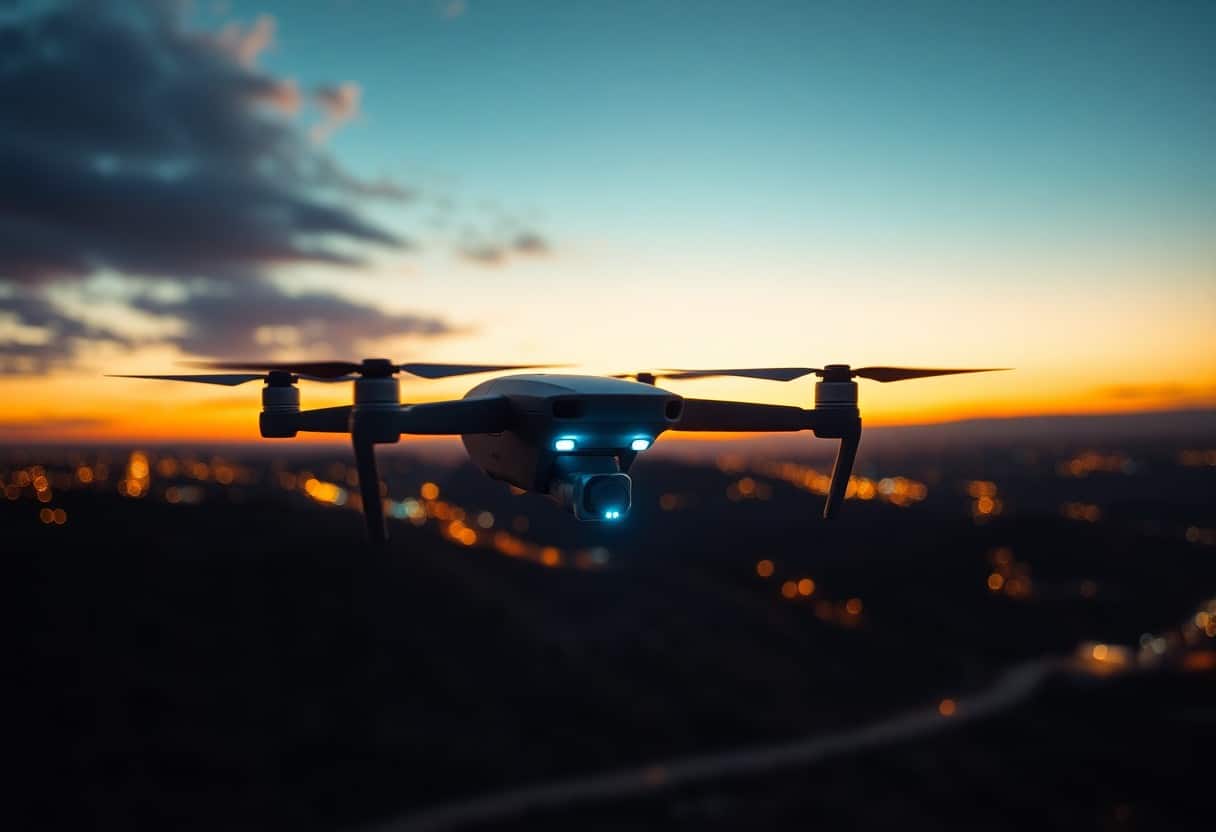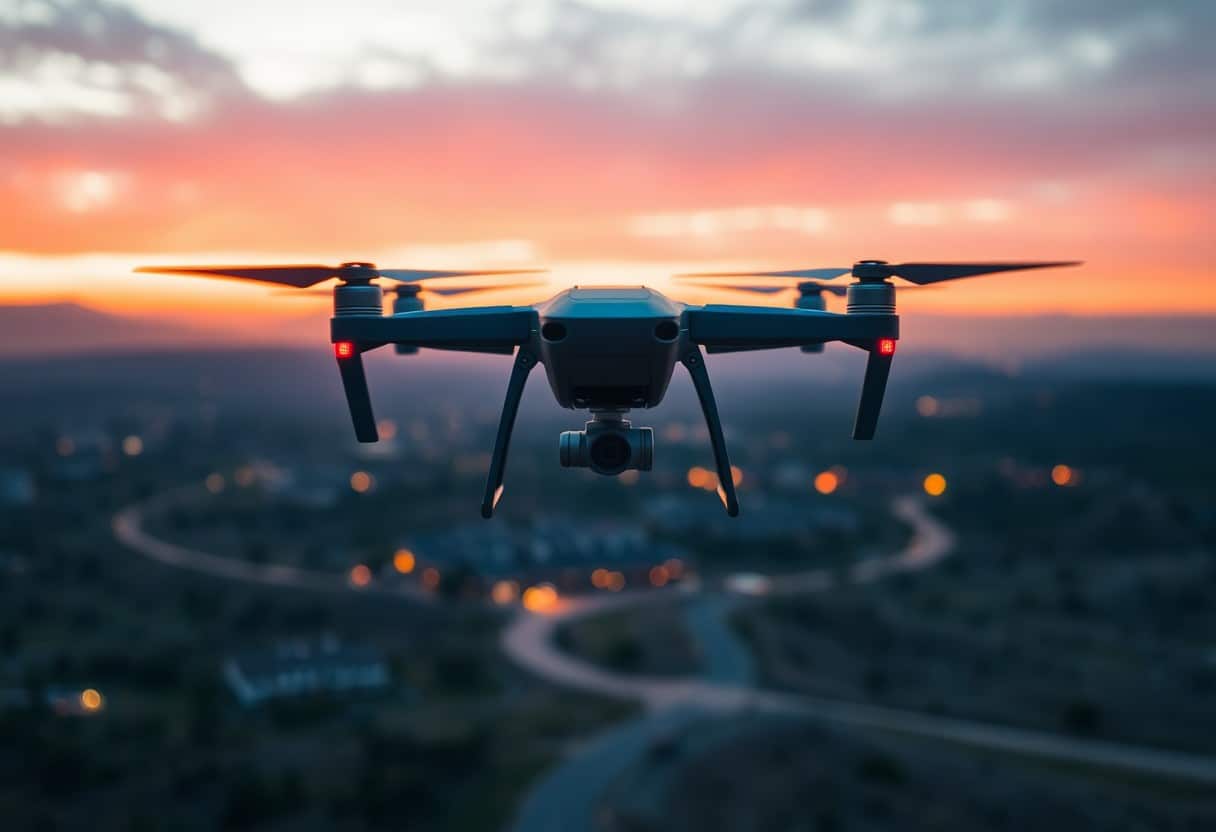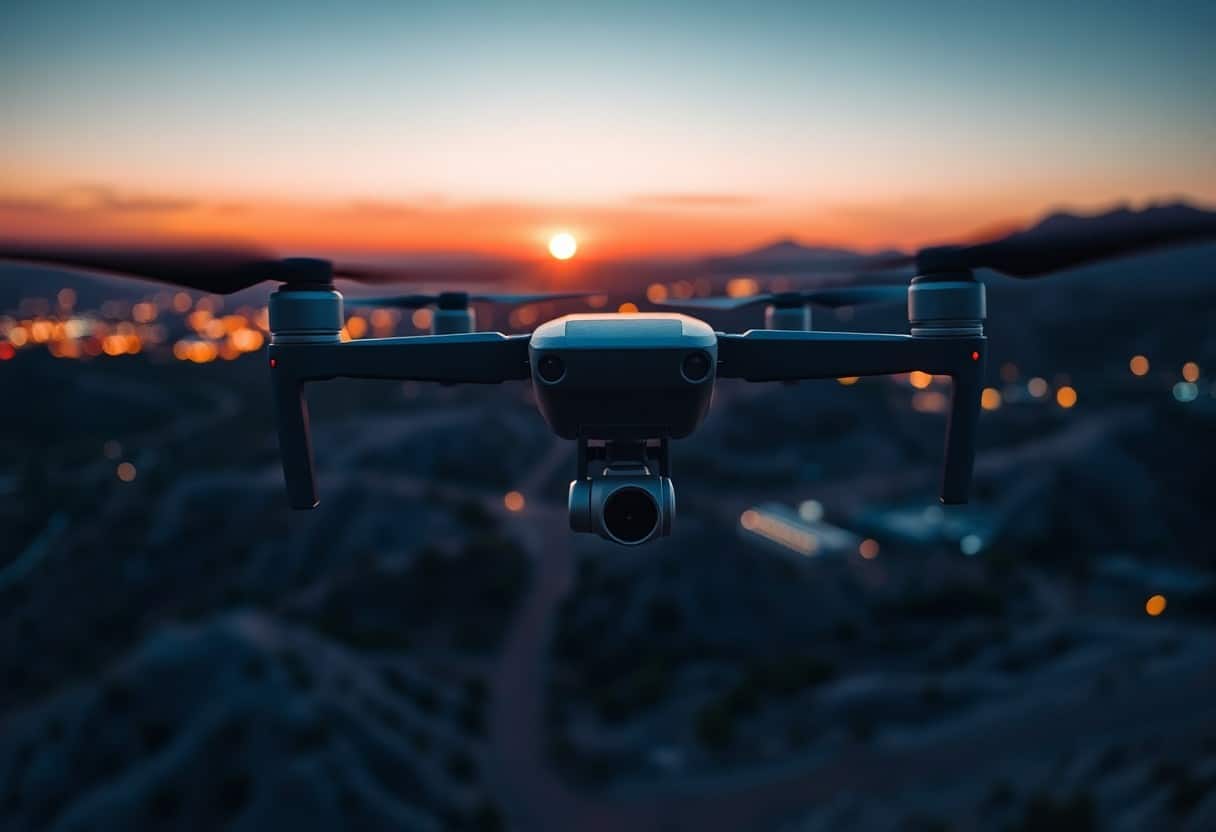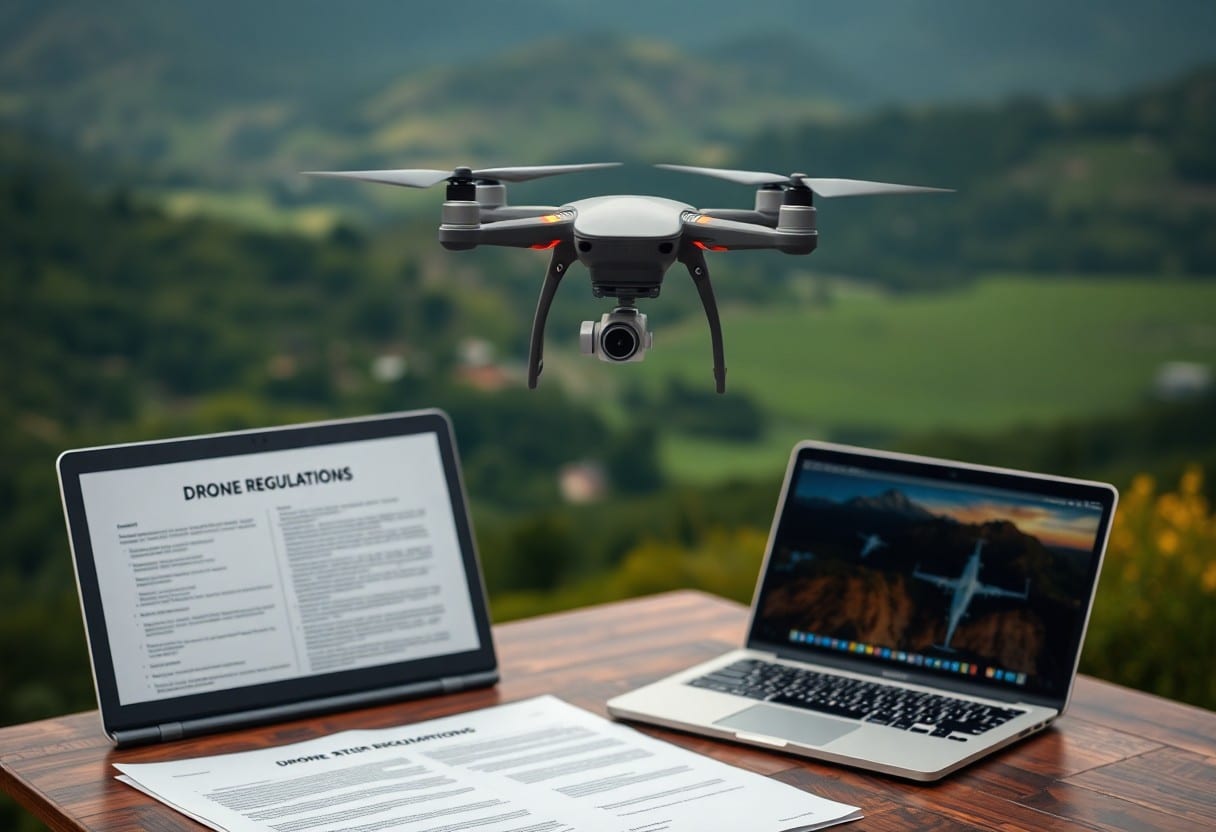What are the best practices for lighting in drone photography?
In Drone Photography.Use of lightIt's essential to create stunning images. Whether you're capturing a stunning sunrise or a spectacular sunset, theBest Practices for Mastering Lightcan help you improve the quality of your photos. You need to considerDirection of light,time periodrespond in singingEnvironmentYou will also learn to utilize natural light to enhance the layering and emotional expression of your images. As your skills improve, you will be able to utilize these techniques more effectively to create unparalleled work.

Key Points:
- natural lightThe best time to shoot is early morning and late afternoon to get a soft light.
- Avoid direct sunlight: Shooting in the middle of the day creates too much shadow and affects the quality of the photo.
- Light Angle: Adjust the shooting angle according to the direction of the light to avoid reflections and overexposure.
- Using Filters: The use of polarizing filters or ND filters can effectively reduce reflections and improve picture quality.
- Adjust White Balance: Adjusts the white balance according to the shooting environment to ensure true colors.
- Shooting position: Choose a high point or an open area for better light and vision.
- Post-processing: Adjust brightness and contrast through post-production software to enhance the overall effect of the photo.
Understanding Natural Light
In Drone Photography.natural lightIt is one of the most influential elements. The distribution of natural light changes over time and climate, affecting the texture of your photographs and emitting strong emotions. Understanding how to capitalize on these changes will help you create compelling images that will enhance your photography skills.
Golden Hour
The dusk and dawn hours are calledGolden HourThis is a favorite time for photographers. The soft light and rich colors of this time provide a natural halo effect to your photos. By taking advantage of the golden hour, you'll be able to capture a unique atmosphere that will make your work more visually appealing.
Cloudy and Sunny Conditions
When taking photos, cloudy and sunny conditions can have an impact on your photos.different effectCloudy days provide a soft, diffused light that's ideal for detail shots. Cloudy skies provide soft diffused light for detail shots, while sunny skies produce strong shadows and contrast. ButToo sunny.days may result in overexposed photos and loss of detail.
When choosing between cloudy or sunny days, you can consider your subject matter. Cloudy angels have a softer light, which makes them ideal for photographing landscapes and details, and helps to avoidRaw ShadowsSunny days are good for high-contrast photography, especially when taking pictures of brightly colored objects. However, you should be aware thatToo much sunlightThis can lead to loss of detail in white and bright areas, so it is also important to control the exposure parameters properly when shooting on a sunny day.

Artificial Lighting Technology
In drone photography, proper artificial lighting techniques can significantly enhance the quality of your photos. Use10 Powerful Steps to Enhance Your Drone PhotographyThe technique allows you to capture clear and vivid scenes in low-light environments.
Use of LED lights
LED lights are a common artificial lighting option used in drone photography. By installing high brightness LED lights, you can get the best of both worlds when shooting.Bright and clearThe LED lights can be used to capture the image of your drone, especially at dusk or at night. In addition, the low power consumption of LED lights can extend your drone's flight time.
Strobe and Flash Options
Flashes and flash options can add different creative effects to drone photography. You need to considerFlash IntensityThis ensures that there is enough light to emphasize the subject during shooting. However, please note that too strong a flash may cause overexposure of the image and affect the quality of your work.
When choosing strobes and lights, you should select adjustable fixtures that will help you in different environments and scenes.Flexible adjustment of light intensityIn addition, the use of multiple strobes can be used to create a more dramatic effect. In addition, the use of multiple strobes creates aA more hierarchical feelThe light effect adds depth and detail to your photographs. However, be sure to operate the flash within safe limits to prevent accidents.
Positioning & Angles
In Drone Photography.Correct Positioning and PerspectiveIt's the key to getting the best out of your lighting. By understanding the direction and mood of the light source, you can find the best position to give depth and dimension to your image. See this article onBasic Steps - How to Start Drone Mapping and Aerial 3D ReconstructionIt helps you to get more inspiration.
Optimum light angle
When shooting, choose thebest angleIt is important to capture the ideal light. Typically, theGolden Hour(Sunrise and Sunset) Providing natural, soft light enhances the beauty of the image. Never shoot in midday sunlight, which creates strong contrast and shadows.
Utilizing Shadows
Shadows can be used in drone photography to enhance the image of theStereoand emotions. Learn to utilizeLight and ShadowYou can add a touch of artistry to your work by changing the angle at which you shoot. By changing the camera angle, you can create unique and compelling images that will bring your photos to life.
Shadows and shadows not only shape the image, but also guide the viewer's eyes. Emphasizing the presence of shadows in your work can make your image full ofMotionIt also enhances its visual appeal. The use of contrast makes the main subject stand out, while the shadows in the background add layers to the composition. Choosing the right time of day, such as early morning or dusk, will soften the shadows and give your image an unmistakable aesthetic.

Adjusting Camera Settings
In drone photography, adjusting your camera settings is a crucial step in getting the desired results. You need to understand how to configure your camera equipment for different lighting conditions. Choosing the right ISO, shutter speed and aperture settings can help you capture clear, bright images. For more information, seeMastering Drone Controls - 7 Steps to Improve Flying SkillsThe
ISO, Shutter Speed and Aperture
Using the correct ISO, shutter speed and aperture will determine the brightness and sharpness of your image. In low-light situations, you may need to increase the ISO to get more light, but theNote that too high an ISO will result in increased noise.. The extra shutter speed freezes the action, while the aperture affects the depth of field, giving you control over foreground and background blur.
White balance considerations
Choosing the right white balance is an important step in obtaining true colors. You will need to adjust your camera's white balance setting when you take pictures under different light sources. Doing so not only helps to capture the right colors, but also prevents the image from being off-color.
In Drone Photography.The correct setting of white balance can significantly affect the quality of the image.. If the color tone of the light in the recording environment changes, such as from daylight to shadow, you should consider adjusting the White Balance in real time. Otherwise, you may obtain images that are bluish or yellowish. You can select Auto or Manual Mode depending on the light source to ensure true and consistent colors.
Post-processing Lighting Adjustment
In post-processing, lighting adjustment is an important step to enhance the quality of your drone photography. You can adjust exposure, contrast, and color uniformity with professional editing software to make your images more appealing and convey the right emotion. Make sure you understand the use of different adjustment tools to maximize the potential of your shots.
Enhanced natural light
Enhancing natural light is an effective way to improve your drone photography. By adjusting the brightness and contrast, you can brighten the light and emphasize the details in your image to convey the movement and realism of the scene. In post-production, look closely at the direction and texture of the light source to bring the final product to life.
Correct over- or underexposure
Correcting overexposure or underexposure is a common challenge in post-processing. An overexposed image results in a loss of detail, while an underexposed image appears dark and lackluster. By using the Edit tool to adjust the brightness and darkness levels, you can effectively restore detail and color to your images. take note ofHowever, over-adjustment may result in deterioration of the picture quality, so caution should be exercised.
When you are faced with an overexposed or underexposed condition, the first thing you should do is to lower or raise the exposure using the adjustment slider of your image editing software. You can use theCurve Toolsto precisely change the brightness of light and dark areas for a more balanced visual effect. You can also change the brightness ofEnhanced ContrastThis will not only save the original image quality, but also give your work more impact. Remember to compare the original image after making adjustments to make sure your adjustments don't affect the overall natural feel. Of course, moderate adjustments can give your images a new look and a stunning visual effect.
Tips for Specific Drone Lenses
Understand that when doing specific drone photographylightIntegration with the scene is crucial. Whether you are photographing a magnificent natural landscape or a vivid event, the lighting decision will directly affect the quality of the shot. Here are some useful tips:
- Select a differentShooting Timefor optimal light and shadow.
- utilizationshadowCreates a sense of layering in the screen.
- Keep the camera steady to avoid blurring due to changes in light.
Enhancing your drone photography skills will help create stunning visual effects.
Landscape Photography
On the setSceneryYou should look for the best lighting conditions to emphasize the beauty of nature. In the early morning and at dusk, the light is soft and creates stunning colors and shadows.
Portraits & Events
proceedportraitsrespond in singingEventsLighting is an important factor in enhancing the quality of your work when it comes to drone photography. You need to choose the right light source according to the needs of the occasion and take care of theLocation of Officerswith the angle of sunlight. Also, try to avoid shooting in the middle of the day, as the strong sunlight at this time may cause unwantedshadowThe
When photographing events or portraits, goodlightIt can greatly enhance performance. Use reflective panels to soften the light or use additional indoorLighting EquipmentYou can get better results. At the same time, pay attention to the contrast between the brightness of the background and the subject, which not only enhances the clarity of the photo, but also makes the characters more prominent. Ensure that you are well-prepared for the shoot and fully understand the lighting environment on the scene, which will allow you to get the best results.portraitsrespond in singingEvent PhotographyThe work is more artistic.
Best Lighting Practices in Drone Photography
In drone photography, good lighting is essential to obtaining quality images. You should choose to shoot during the golden hour when the light is soft and colorful. In addition, you can use reflectors and softening devices to improve the light. Avoid shooting in the middle of the day to prevent strong shadows from affecting the quality of your images. Finally, check your camera settings regularly to ensure proper exposure and white balance for optimal results.
Frequently Asked Questions
Q: When is the best time to use light in drone photography?
A: The best time to use light is usually during the golden hour, after sunrise and before sunset. The light during this time is soft and colorful, which enhances the beauty of your photos.
Q: How do I adjust the drone's exposure settings for best results?
A: In drone photography, it is very important to adjust the exposure value (EV), shutter speed and ISO appropriately. It is usually recommended to choose a lower ISO when there is sufficient light to minimize noise, while maintaining a proper shutter speed to prevent blurring.
Q: What are the benefits of using ND filters for drone photography?
A: ND filters (Neutral Density Filters) reduce the amount of light entering the lens, allowing the photographer to use slower shutter speeds, increase the motion blur effect, and still capture the best quality images in bright light.
Q: How should I adjust my shooting strategy in cloudy or cloudy light?
A: In cloudy or overcast light, it is recommended to use a higher ISO to compensate for the lack of light and try to capture the texture and layering of the clouds, which can create images with unique colors and emotions.
Q: How can I use natural light to enhance my drone photography?
A: Using natural light, you can choose to shoot at different positions and angles for different time periods, try a low angle to capture the backlight effect, or choose to shoot facing the light source to increase the texture and three-dimensionality of the image.
Q: How to avoid light reflection or glare problem in drone photography?
A: To avoid light reflection or glare, it is recommended to use a polarizing filter (CPL) to reduce non-essential reflections, and optionally adjust the shooting angle to minimize direct light into the lens.
Q: What are the light safety considerations when doing drone photography?
A: When taking drone photography, you should avoid flying under strong sunlight for a long period of time to avoid overheating, and you should also understand the local flight restrictions and safety regulations to ensure that you are operating within the permitted time and space.




